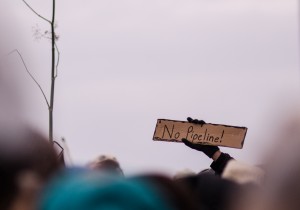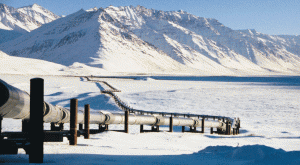
https://www.flickr.com/photos/leadnow/10896436383
TransCanada’ Energy East is a proposed pipeline for Alberta diluted bitumen that would be the biggest such pipeline on the continent, bigger than Keystone XL. Today, October 30th, 2014, TransCanada submits the Energy East proposal to the National Energy Board of Canada.
In Part 1 of this essay, the answer to the question “Is Energy East just?” was found to be no, not as currently proposed. In Part 2 of 2, David Gray-Donald explores the question, “could it become just?”
For TransCanada’s proposed Energy East pipeline project to be considered just it would have to:
1. Decolonize relations with indigenous peoples and First Nations
2. Be part of a climate change plan (mitigation and adaptation) that is comprehensive and mutually agreed to around the planet
3. Share wealth to undo the continuing unfair burdens and benefits
These steps are difficult but necesssary. The players pushing for Energy East –TransCanada, Irving, the Canadian Association of Petroleum Producers (CAPP), Steven Harper – are powerful and could affect change in this direction.
These steps are necessary but not sufficient to to balance the scales of justice. Seeing as it is hard to imagine these basic necessary steps will be taken in the current political climate, one must conclude that the chances the Energy East project will be just are nearly nil.
The rest of this text expands on the three basic conditions and concludes with a discussion about how energy projects can be designed with justice front of mind.
1. Decolonize relations with indigenous peoples and First Nations
Background
Canada, and the corporations that operate with its permission like TransCanada, do not respect the treaties that exist with First Nations groups. Not in spirit nor by what was written in English words. Many treaties call for non-interference between the parties but Canada and its corporations continue to violate this basic agreement. This is unjust.
To start moving to justice
TransCanada must push for indigenous societies to be allowed to form their own governments, reversing the Government of Canada imposition of band council elections. This basic sovereignty is in the spirit of the treaties. While communities could choose to alter their governance from that of traditional ways (eg. Longhouse), it is unjust for Canada to impose a governance system on people where it has no such legitimate jurisdiction. TransCanada must work to undo this colonial interference before claiming it has free, prior, and informed consent of indigenous communities.
When speaking of indigenous communities it is necessary to speak of Indian Status. This sexist and racist Canadian legislation must be changed in order for First Nations communities to form as per the spirit of the treaties and in cases where no treaties exist. TransCanada must work to this end before it can claim Energy East is being agreed to in a just fashion.
Energy East, proposed to be the biggest such pipeline on the continent and designed primarily to allow bitumen extraction to expand greatly, directly affects peoples in nine provinces (mega-tankers will be travelling along the maritime coasts). Governance of land and waters in Canada is, as per the spirit of the treaties, to be a matter of shared responsibility between indigenous and settler communities. TransCanada would need to insist on this basic change in governance being made.
If the spirit of the treaties has changed for either side, they can be renegotiated in good faith.
Breaking treaties and using violence to control people is war. That is what has been happening across Canada for hundreds of years. Continuing this long war of broken promises and physical force in order to build a pipeline puts TransCanada on the wrong side of justice. To work toward peace, TransCanada must insist on Canada honouring its treaties or renegotiating them in good faith.
2. Be part of a climate change plan (mitigation and adaptation) that is comprehensive and mutually agreed to around the planet
Background
The current plan of TransCanada, CAPP, and the Canadian government is to get bitumen dug up, sold, and consumed as quickly as possible on the free capital market. This is a disaster for the planet’s climate.
To start moving to justice
TransCanada and CAPP would need to make a compelling and binding case that Energy East is part of the transition off of fossil fuels. As it is an expansion of fossil fuel infrastructure designed to expand the tar sands, this is a difficult case to make (expanded in step 3).
That being the case, TransCanada would need to hold off on the infrastructure expansion until a binding international plan is in place. TransCanada and CAPP are already lobbying governments around the world for specific goals. It is the nature of the goals that need to change. TransCanada and CAPP are in well-connected positions of authority to call for a just global climate plan. This may involve becoming B Corps or other types of organization where duty is to stakeholders, the citizens of the world, and not to a small number of shareholders.
This binding international plan may call for profits made on greenhouse gas-emitting activities to be used for mitigation and adaptation strategies.
Mitigation, reducing the impacts of climate change by reducing emissions, could involve dispersed efforts of a Manhattan Project scale. The Manhattan Project used public resources during Word War Two to put minds together with the goal of making major technological breakthroughs. What is needed now are many concerted efforts around the planet to reduce emissions (not make bombs). Support is needed to make major changes in energy efficiency, energy reduction through lifestyle change, new energy technologies, stopping release of non-combustion gases (eg. methane in agriculture), etc. Proposals in this vein are numerous. If CAPP sincerely focused on these solution strategies they could be a force for climate justice.
Adaptation would require supporting massive projects as well. TransCanada, CAPP, and Canada have the ability to make such supports available. These may include ensuring communities around the world are prepared for flooding, storms and drought (including good public facilities and services for during crises), and are resilient in terms of soil health and other ecosystem services.
TransCanada would need to demand that most of the profit from Energy East, and among CAPP members, are used to build this transition away from an increasingly high-carbon economy. Currently, without any hint of such a plan, TransCanada cannot move forward with a just Energy East project.
3. Share wealth to undo the continuing unfair burdens and benefits
Background
Those with least access to money and oil who benefit least from the project are often those most affected by climate change. Those who will make money from Energy East are those who already have wealth and use disproportionately more oil than the rest of the world.
To start moving to justice
Energy in the bitumen moved through Energy East could be for use by those who have traditionally benefited least from use of refined petroleum products. This would require a large shift in who has access to wealth and where it becomes concentrated. It is not as if the shipping of bitumen to India will mean quality of life improvements for India’s poorest. (Clean-oil rich Saudi Arabia does not see its poorest benefitting from major extractive projects, and neither does Canada.) TransCanada and CAPP can be a force for demanding that those who have the most to gain from access to oil get that access. They have the power to fight to ensure it is not used unjustly to uphold lifestyles of the rich around the world.
To break apart extreme wealth concentrations, profits from Energy East could be used to support dispersed mitigation and adaptation strategies. Step 2 describes some such efforts. These would need to not be led only by the elites of communities around the world, but ensure that the people are empowered everywhere. CAPP has the political energy and chemical energy to contribute to this massive transition.
Putting justice at the forefront of energy projects
Energy projects usually play with fire. Literally. Fire can inflict damage in many ways, and it is therefore a force with which we need to be very careful. As with fires in a community, it is impossible to know how damaging climate catastrophes will be.The earth’s reactions to change are unpredictable. Fire departments demand strong plans for preventing and putting out fires. In the same way, we need to collectively build strategies to get away from our current planet-disrupting ways of burning fossil energies. We need to talk about what is socially acceptable to do on – and to – this planet. Instead, a group of people who organize themselves under the name TransCanada Corporation have 26 lobbyists registered in the province of Quebec alone, many of them working on convincing people of the social acceptability of their project. In place of honest conversations as a human community, we hear from those paid to manufacture consent by whatever means necessary.
Energy projects can be designed with justice as their guiding principle. But TransCanada has not embraced that thinking with Energy East. It is indistinguishable from older energy projects, remarkable only in its size. The basics of justice are not to be found.
David Gray-Donald studied Environment & Biology at McGill University then worked there facilitating community sustainability projects. He is actively part of the struggle to undo our reliance on fossil fuels and is trying to educate himself on how to be a responsible adult male. He lives in Montreal and Toronto.
